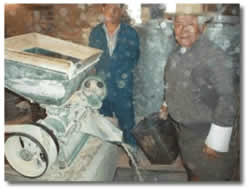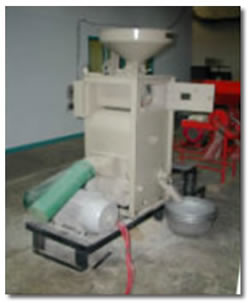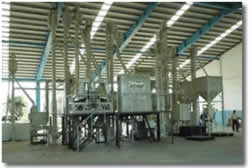|
|
Milling |
|
|
|
|
|
|
|
Milling systems |
|
|
|
|
|
|
|
Describe the different rice milling systems |
|
|
|
|
|
|
|
Remember: Rice milling = removing the husk and bran layer to produce white rice |
|
Milling can be done in 1 or more steps |
The process of milling can be done in:
One step: husk and bran are removed in one go. White rice is produced directly from paddy.
Two steps: husk and bran are removed separately. Brown rice is produced as an in-between product.
Multiple steps: Rice goes through different operations and machines to turn paddy into white rice. |
|
|
|
1. One step milling
Hand milling Pounding of paddy in a mortar with a crusher is still practiced in some areas. Husk and some bran layers are removed by rubbing the grains against each other. This gives a high percentage of broken kernels. The final cleaning is done by winnowing and separation by hand.
Pounding of paddy in a mortar |
|
|
|
The steel single pass mill The single pass rice mill is an adaptation of the "Engleberg" coffee huller. This type of mill is still very popular in many of the poorer rice-growing countries. It is widely used for milling of household rice. This mill is a steel friction-type mill and uses very high pressure to remove the hull and polish the grain. This results in many broken kernels, low white rice recovery of 50-55% and head rice yields less than 30% of the total milled rice.
The single pass rice mill |
|
|
|
2. Two Step Milling
Compact Mill Two stage mills are often called compact rice mills and in many countries have replaced the Engleberg mill. The two-stage mill has separate hulling and the polishing processes. Rubber rollers remove the husk and the brown rice is then polished with a steel friction whitener. These mills have a capacity of 0.5 to 1 ton per hour paddy input and are often used for milling in the rural areas. The milling performance of the compact rice mill is better than the single pass huller with milling recoveries normally above 60%.
The compact rice mill |
|
The modern milling process, keeps losses to a minimum |
3. Multiple step rice millingThe milling process in big commercial mills combines a number of operations that produces higher quality and higher yields of white rice from paddy or rough rice.
A multiple step rice mill
The Modern Milling Process |
|
|
|
||
|
|
Exercise: Put the operations in the right order |
|
What happens when? |
|
|
|
|
|
|
Next lesson |
This concludes this module and this course on the post production of rice. Take a moment to look at who made this course. |
|

![obj[1]](obj_1_.gif)



